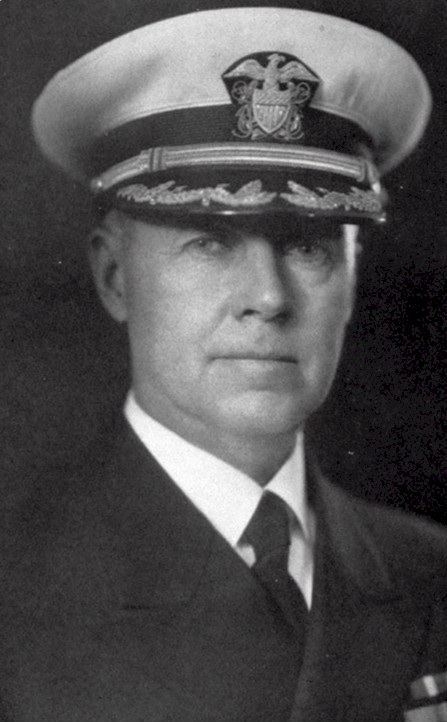Years of service 1903–1945 Role Admiral | Name Henry Cooke Rank Rear Admiral | |
 | ||
Born September 21, 1879Washington, D.C. ( 1879-09-21 ) Allegiance United States of America Battles/wars Philippine–American WarWorld War IWorld War II Commands held USS Oklahoma (BB-37), USS Allen (DD-66) | ||
Henry David Cooke, Jr. (September 21, 1879 – July 7, 1958) was a highly decorated rear admiral in the United States Navy who served as the commandant of midshipmen between years 1931–1932 and as convoy commodore during World War II. He was a grandson of Henry D. Cooke, First Governor of the District of Columbia.
Contents
- Early naval career
- World War I
- Navy Cross citation
- Interwar years
- World War II
- Postwar life
- Decorations
- References
Early naval career
Cooke was born on September 21, 1879, in Washington, D.C. as a son of Henry David Sr. and his wife Anna Howell Cooke. Cooke attended the public schools in Washington, D.C. and New York City and subsequently was appointed to the United States Naval Academy at Annapolis, Maryland, in September 1899.
Cooke graduated in 1903 and served almost two years at sea as a passed midshipman. During this two years, he was first assigned to the USS Mississippi and then he was transferred to the Asiatic Fleet, where he was assigned to the USS Pampanga, schooner-rigged iron gunboat, which was originally a ship of the Spanish Navy, captured by U.S. Army in June 1898. Cooke participated aboard USS Pampanga in patrol duty around Island of Jolo, where he was wounded by Moro Rebels in 1904. He was later awarded with Purple Heart for these wounds.
After recovery from his wounds, Cooke was assigned to the instruction course in ordnance at Washington Navy Yard. After completing his course, he was transferred to the USS Virginia and participated in a world cruise within this battleship.
Upon his return to the United States, Cooke was transferred to the United States Naval Academy at Annapolis, Maryland, where he was appointed an instructor of physics, chemistry and electrical engineering. He served in this capacity until 1912, when he was ordered back to sea, now as engineer officer of USS Georgia and then as commanding officer of destroyer USS Henley. Upon his return in summer of 1915, Cooke attended Naval War College in Newport, Rhode Island.
World War I
After completing the course at Naval War College, Cooke was transferred to the industrial department of Brooklyn Navy Yard in New York City. He was subsequently transferred to command USS Kanawha II, an armed yacht operating out of Brest, France during the early period of World War I.
Cooke was later transferred to command destroyers USS Jenkins and USS Allen. During the command of destroyer USS Allen, Cooke was ordered for patrol duty off Queenstown, Ireland, where he was tasked with protection of important convoys of troops and cargo ships through the area of submarine activity. For his brilliant service in this capacity, Cooke was later awarded with the Navy Cross (See the citations below).
During the early period of 1918, Cooke was appointed temporary commander of Naval Air Station Lough Foyle, Ireland, before he was ordered back to the United States. Upon his return, Cooke was ordered to supervise the launching of destroyer USS Harding at Union Iron Works in San Francisco.
Navy Cross citation
The official U.S. Navy citation for Cooke's Navy Cross reads:
Action Date: March 11 & 16, 1918Name: Henry David CookeService: NavyRank: CommanderCompany: Commanding OfficerDivision: U.S.S. AllenCitation: The President of the United States of America takes pleasure in presenting the Navy Cross to Commander Henry David Cooke, United States Navy, for distinguished service in the line of his profession as Commanding Officer of the U.S.S. ALLEN, operating in the War Zone and protecting vitally important convoys of troop and cargo ships through the area of submarine activity, and for prompt and efficient action in contacts with enemy submarines on March 11 and 16 March 1918.Interwar years
Cooke was subsequently transferred to the Navy Recruiting Bureau in New York and tasked with recruiting duty. His next assignment was back at the Naval Academy in Annapolis, Maryland, where he was appointed a head of department of electrical engineering and physics. He served in this capacity for next two years.
His third tour at the Naval Academy came in 1931, when he was appointed a director of athletics and subsequently a commandant of midshipmen. Cooke succeeded Charles P. Snyder in this capacity.
World War II
Cooke was transferred to the retired list of the Navy in June 1939, but he was subsequently recalled to the active duty the same year. He was assigned to the office of the Chief of Naval Operations under the command of Admiral Harold R. Stark. At the beginning of March 1942, Rear Admiral Cooke was appointed a convoy commodore.
His main responsibility was command and control of important sea convoys of military personnel and supplies vital to the maintenance of the Allied forces overseas. Cooke was also in the close contact with Merchant service and other Allied naval units and participated in the improvement of the convoy system. Cooke stayed in this capacity for the rest of the War. He was later decorated with the Bronze Star Medal with Combat "V" for his service in this capacity.
Postwar life
Cooke was relieved of all active duty during the second half of 1945 and joined his wife Elinor Talbot Cooke (1887–1971) at their residence at Long Island, New York City. Cooke died on July 7, 1958, at the age of 78 in East Hills, New York, and is buried together with his wife at Arlington National Cemetery, Virginia.
Decorations
Cooke´s ribbon bar:
